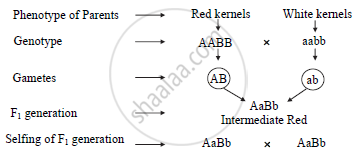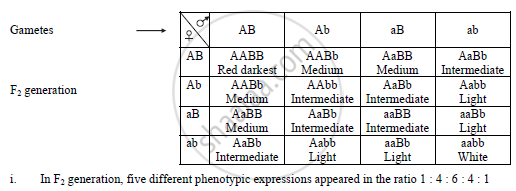Advertisements
Advertisements
Question
Describe quantitative inheritance controlled by two pairs of genes.
Solution
- Quantitative inheritance is also known as polygenic inheritance in which characters are determined by two or more gene pairs which have additive or cumulative effect. These genes are called cumulative gene or polygenes.
- This quantitative inheritance can be explained by wheat kernel colour which is controlled by two pairs of genes Aa and Bb.
- H. Nilsson Ehle crossed red kernelled variety of wheat with white kernelled variety.
- Gene A and B determine the red colour of kernel (responsible for producing red pigment) and are dominant over their recessive allele a and b which do not produce red colour pigment and the expression is white, if dominant gene is not present. Thus, genotype of a parent with
red kernels is AABB and that of parent with white kernels is aabb. Genotype of F1 hybrids is AaBb. - Continuous variations in expressions is observed as each dominant gene produces specific amount of pigment and the shade of red colour, depends on number of dominant gene present
as shown in Punnett square. 

APPEARS IN
RELATED QUESTIONS
In Mendel’s experiments, tall pea plants (T) are dominant over dwarf pea plants (t).
What is the phenotype and genotype of the F1 generation if a homozygous tall plant is crossed with a homozygous dwarf plant?
Choose the correct answer:
A cross where two pairs of alleles are considered is a ____________
If a pure tall plant is crossed with a pure dwarf plant, then offspring will be ______.
Describe the cross between a homozygous tall, round-seeded pea plant and a dwarf, wrinkled-seeded pea plant. What will be the types of progeny in the F2 generation of this cross and in what proportion will it be?
Name and state the law which is explained by this example.
Explain Mendel’s Monohybrid cross. Give an example.
Multiple Choice Question
Who among the following is called father of genetics?
Which one from those given below is the period for Mendel's hybridization experiments?
Mendel studied interitance of seven pairs of traits in pea which can have 21 possible combinations. If you are told that in one of these combinations, independent assortment is not observed in later studies, your reaction will be.
A gene showing dominance has:
